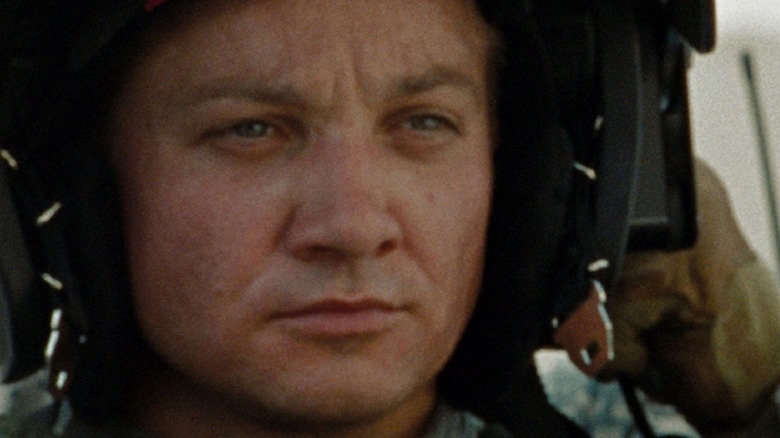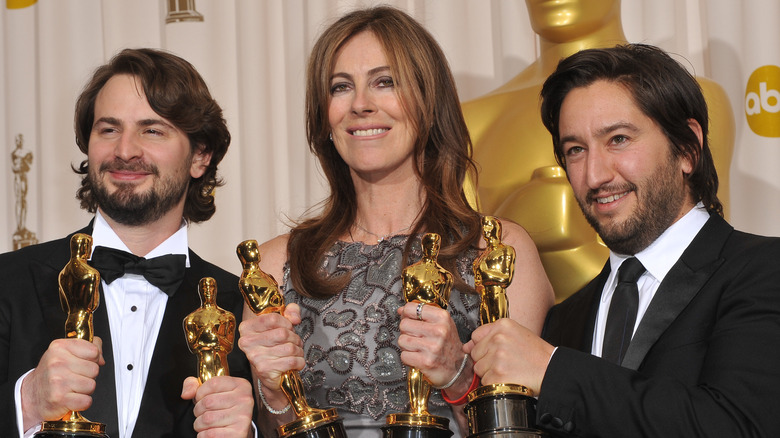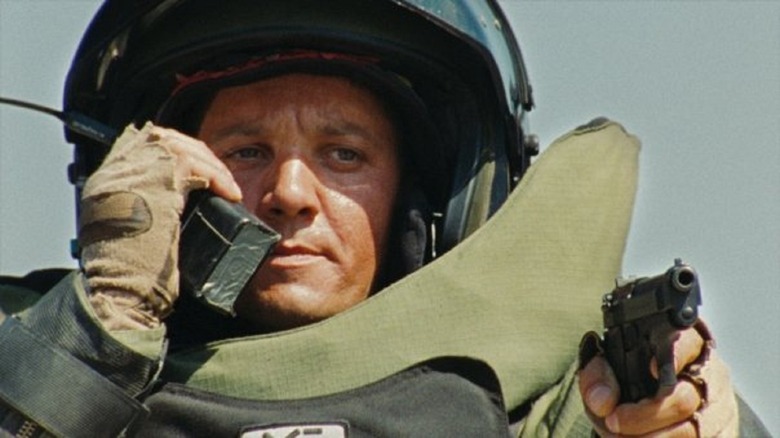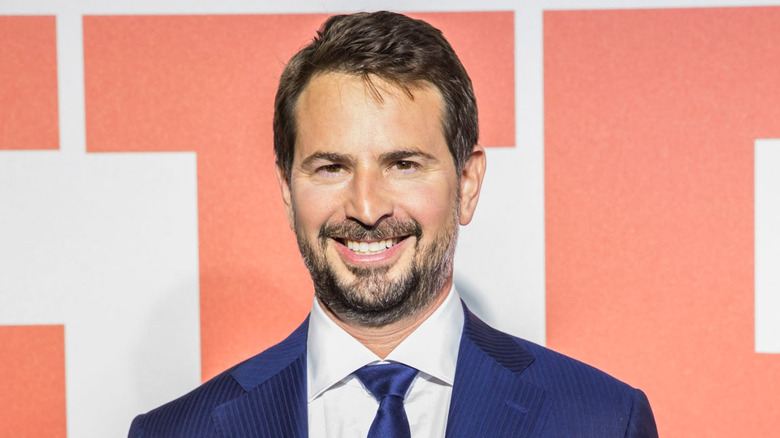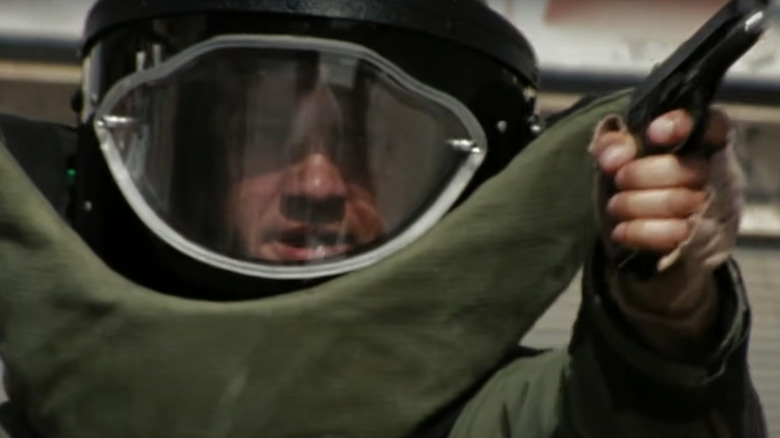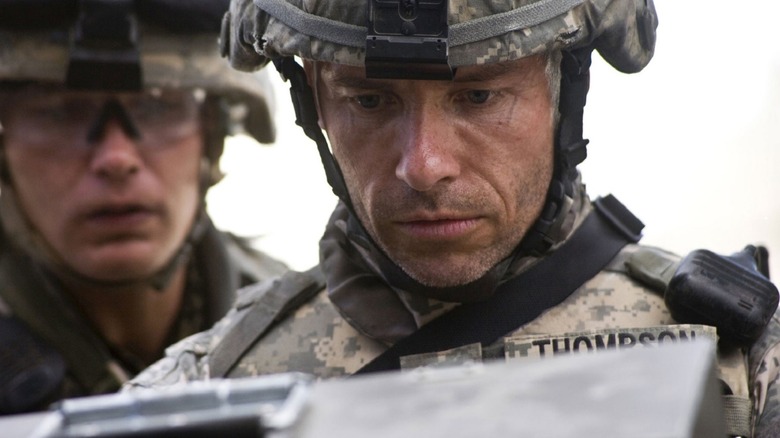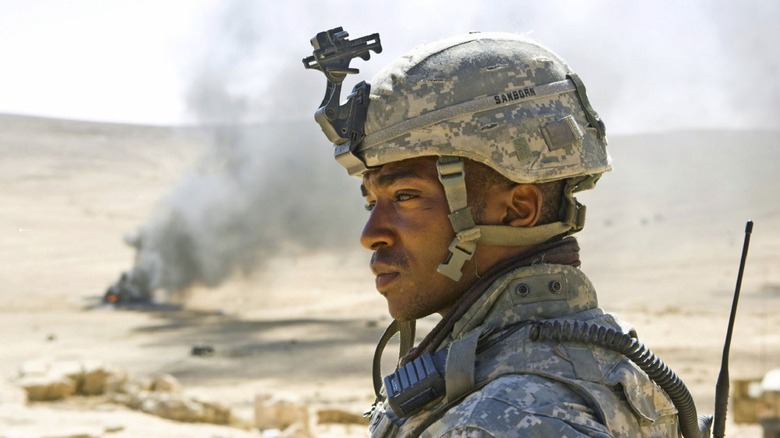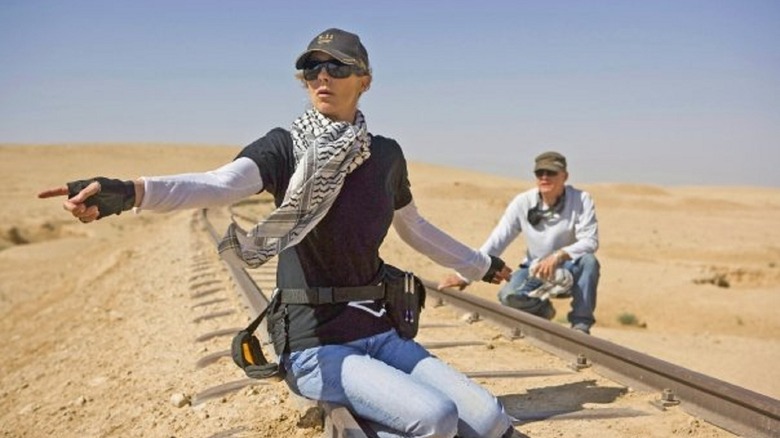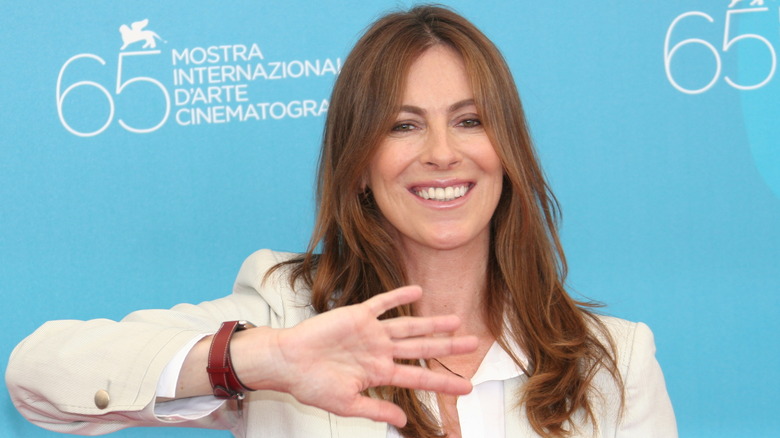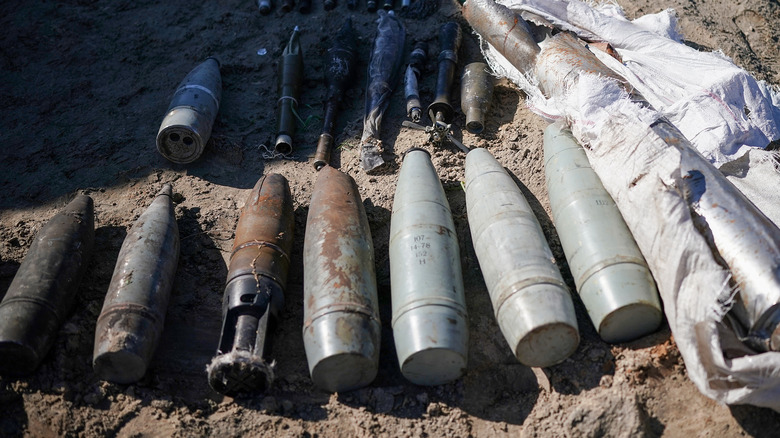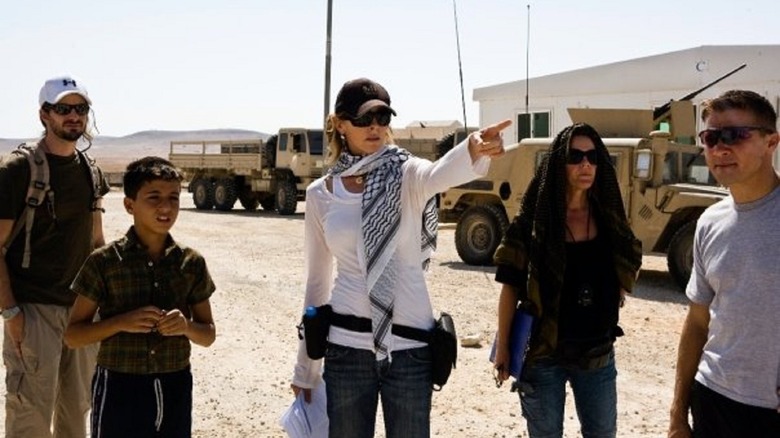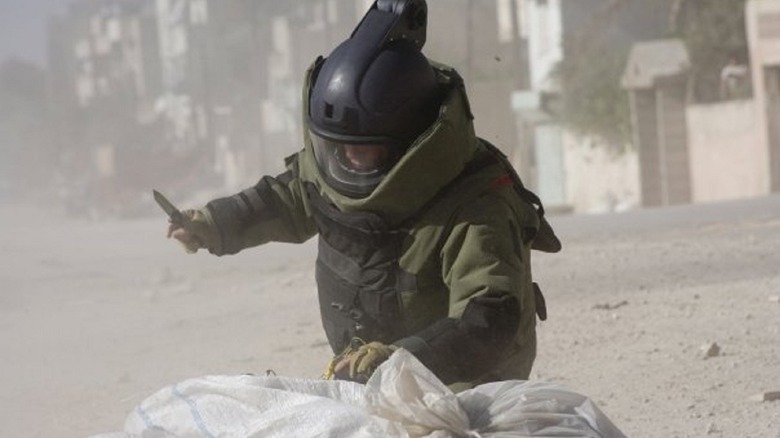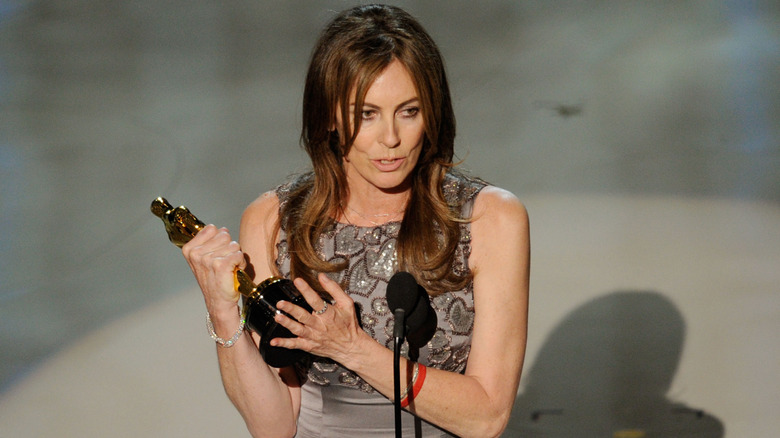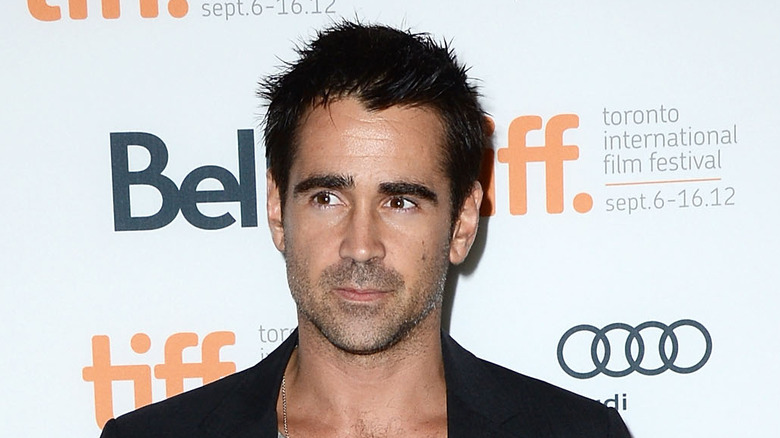The Untold Truth Of The Hurt Locker
"The Hurt Locker" is one of the most critically acclaimed war films of the past two decades. The film was produced by the creative team of Mark Boal, who wrote the screenplay, and Kathryn Bigelow, who directed the film. Before the film, Bigelow was already an established genre film director, with past successes like "Point Break," "Strange Days," and "Near Dark." With her 2002 submarine-based war film "K-19: The Widowmaker," Bigelow turned her camera to the subject of war for the first time and marked a significant shift in focus for her career.
After a six-year break from feature filmmaking, she then returned for another cinematic battlefield with "The Hurt Locker." This would mark the start of a series of collaborations with Boal — including another lens on an American conflict in the Middle East in "Zero Dark Thirty" and the period drama "Detroit" — and earned Bigelow a place in the Hollywood history books.
This post will take a look into how this creative duo worked together and what went into making the movie. However, beyond all of the acclaim and adulation, "The Hurt Locker" was also the subject of many controversies behind the scenes, and we will dig into those as well. This is the untold truth of "The Hurt Locker."
The producers were sued for defamation and fraud
In "The Hurt Locker," Jeremy Renner stars as Staff Sergeant Will James, the newly appointed head of an Explosives Ordinance Disposal team (or EOD for short), who has a uniquely brazen approach to bomb defusal. In real life, an actual U.S. Military sergeant, Jeffrey Sarver, believed that the Will James character was based on him and his experiences on an EOD team. As detailed by The Hollywood Reporter, Sarver sued the distributor Summit Entertainment as well as the producer team behind "The Hurt Locker," which consisted of Kathryn Bigelow, Mark Boal, Greg Shapiro, and Nicholas Chartier.
While Sarver claimed that the character, and to an extent the overall film, was based on him without his permission, he also claimed that the film misrepresented him and portrayed him in a false and negative light. Defamation, fraud, and intentional infliction of emotional distress were included in his lawsuit alongside the claims of misappropriation of likeness, invasion of privacy, and fraud. Boal denied these claims, insisting that the character was inspired by several soldiers that he met and interviewed as a journalist, rather than any individual.
The federal judge assigned to the case ruled strongly in favor of the filmmakers, throwing Sarver's case out of court. In the aftermath, the production team filed an anti-SLAPP motion against Sarver and won. Sarver was ordered to pay the legal fees of the defense team, which totaled approximately $187,000. Sarver attempted to appeal the case, but the decision was upheld by the federal court of appeals.
Thousands of people were sued for pirating the film
Not only were the producers of "The Hurt Locker" sued, but they also found themselves on the other side of a lawsuit as well, with producer Nicholas Chartier leading the charge. The Hollywood Reporter notes that Chartier's legal actions may have led to substantial copyright litigation increases across the country. In one of the largest piracy lawsuits to come out of Hollywood, approximately 25,000 individuals were sued for viewing the film illegally. All of these illegal viewings came through the website BitTorrent, and the lawsuits were handled by the same team, the U.S. Copyright Group, or USCG for short. Each of these 25,000 individuals was faced with paying a $2,000 settlement or suffering a piracy lawsuit in court.
The lawsuit and USCG as an organization were extremely controversial, both for dabbling in some questionable tactics and for going after "John Does," aka private citizens. USCG went as far as to subpoena ISPs in order to obtain the identities of the torrenters. The amount of money being sought was another point that drew criticism toward USCG; if everybody who the USCG targeted for torrenting "The Hurt Locker" paid their requested settlement, they would net approximately $50 million, which is nearly triple the size of the film's entire domestic box office gross of $17 million. Ultimately, hundreds of the claims were settled out of court.
The writer pulled from his own experiences in Iraq
The original screenplay for "The Hurt Locker" was written by Mark Boal, who also produced the film. Much of the background of the film came directly from Boal's own experiences in Iraq. As a war journalist, Boal was embedded with an EOD unit for a significant period of time where he was able to observe their actions up close and interview the squad members extensively. Director Kathryn Bigelow called him the driving force in getting the movie made, and they would go on to collaborate again in the same capacity on Bigelow's next two films, "Zero Dark Thirty" and "Detroit."
Before he headed to Iraq as a journalist, Boal was already acquainted with Bigelow. Bigelow had already been on the lookout for a story she could tell about the Iraq war and saw Boal's journey as a perfect "entry point" for the story.
Jeremy Renner's costume weighed 100 pounds
The costume that Jeremy Renner's character wears when diffusing bombs was a real bomb-disposal suit. The bulky outfit weighed about 100 pounds and was comprised of multiple pieces that evenly distributed the weight throughout his entire body. Constructed out of Kevlar and metal plates, the suit was sturdy enough to protect Renner from a real bomb blast.
Shooting scenes in the bulky suit was a challenge as it severely restricted movement, was time-consuming to put on and take off, and would further increase the already hot temperature for the wearer. "The Hurt Locker" was shot on location in the country of Jordan in the summer, and temperatures were routinely in the range of 125 degrees. Sandstorms were also a common occurrence throughout the shoot and made production more difficult. The intense heat and sandstorms were challenging enough already for the cast and crew wearing less restrictive outfits, let alone for Renner inside of his 100-pound sweat lodge of a costume.
A non-fiction book inspired the film
Mark Boal's screenplay for "The Hurt Locker" is an original piece of work. Although the script was not an adaptation of any previously existing material, elements of the film were inspired by a non-fiction book. Kathryn Bigelow has cited the book "War is a Force That Gives Us Meaning" by Chris Hedges as the inspiration for the film.
When the film begins, the first thing shown on screen is a quote from author Chris Hedges, "The rush of battle is often a potent and lethal addiction, for war is a drug." This quote encapsulates the core theme of the film as explored through Jeremy Renner's character, Sgt. Will James. Similar to Boal, Hedges pulled from his own experiences as a war correspondent when writing the book. An extended version of the quoted excerpt used in the film relates to the creation of "The Hurt Locker" in a meta way as a piece of media dramatizing war, "The rush of battle is a potent and often lethal addiction, for war is a drug, one I ingested for many years. It is peddled by myth makers, historians, war correspondents, filmmakers, novelists, and the state — all of whom endow it with qualities it often does possess: excitement, exoticism, power, chances to rise above our small stations in life, and a bizarre and fantastic universe that has a grotesque and dark beauty."
There was no ADR used for the film
ADR stands for either Automated Dialogue Replacement or Additional Dialogue Replacement depending on who you ask. It refers to the post-production process in which actors rerecord lines of dialogue and other vocal sounds after shooting has wrapped. This might be done to salvage poor audio captured on set, to tweak a performance, or to flat out change or add dialogue. Most films utilize ADR to one degree or another, the practice is a standard part of the post-production pipeline in filmmaking.
In what is a major rarity in the film industry, there was no ADR used in "The Hurt Locker," as revealed by director Kathryn Bigelow in an interview with DP/30. This feat would be rare enough for a film shot entirely on controlled sound stages, which makes it even more surprising for "The Hurt Locker," considering it was shot almost entirely on location in Jordan. Bigelow confirmed that they actually did attempt ADR for the film at one point before scrapping the idea. They found that the cast simply couldn't recapture the vocalizations that were present during the shoot after the fact in a recording booth.
The film was shot using four cameras simultaneously
A multi-cam shooting style isn't uncommon in the world of television, but most films are shot using a single camera setup. "The Hurt Locker" bucked this trend by utilizing four camera units simultaneously throughout its production. This approach was only possible since the film was shot on location in Jordan, with Kathryn Bigelow explaining, "In the Middle East, where 360 degrees was a perfect angle, and there's a certain immersive quality... there was a degree of authenticity and reality that couldn't be fabricated. It was absolutely real." Being able to shoot in every direction meant that Bigelow could position her four camera units around the shooting location and capture the action from multiple angles simultaneously.
Bigelow worked to ensure that each of the camera units was positioned discreetly and that they each kept a low profile. This helped avoid one camera accidentally catching another camera in the background of a shot, but also had the added benefit of increased immersion for the actors. Jeremy Renner described his experience shooting this way as a positive one, "We call them 'ninja cameras.' They're just hiding all over the place, we never know where anything is." Shooting "The Hurt Locker" multi-cam in this manner contributed greatly to the pseudo-documentary aesthetic of the film.
The low budget was beneficial to Bigelow's process
Though it has the glossy veneer and pedigree of a big-budget studio war movie, "The Hurt Locker" is technically an indie film and was made for the relatively low budget of $15 million. That might sound like a lot of money, but it's a mere drop in the bucket compared to the average studio movie or even when compared to another war movie released the same year, "Valkyrie," which had a production budget of $90 million. Having a smaller budget than average came with a lot of drawbacks for "The Hurt Locker," but it also brought with it a number of advantages to director Kathryn Bigelow's creative process.
Keeping the budget low allowed Bigelow to retain complete creative control over the movie, whereas a larger budget would likely have meant her making concessions to studio heads and possibly compromising her vision. The low budget also put Bigelow in a position where she had the final cut over the edit of the film and enabled her to "cast emerging talent and breakout actors" rather than big-name stars, which a major studio would have mandated. Bigelow cast a then lesser-known Jeremy Renner based on his performance in "Dahmer," Anthony Mackie because of his role in "Half Nelson," and Brian Geraghty due to his performance in "Jarhead."
Real explosives were used when making the film
Given that "The Hurt Locker" is a film all about improvised explosive devices and the EOD unit that specializes in diffusing them, explosions play a key role in the story. Kathryn Bigelow wanted to the explosions in the film to feel as realistic as possible, which was a bit of a challenge to pull off safely considering the film's relatively low budget. Real explosives were used for some of the explosion scenes within the movie, and creative filmmaking techniques were used to maximize their on-screen impact.
Richard Stutsman, the film's special effects supervisor, was tasked with safely detonating actual explosives on location in order to capture the real deal on camera. In the behind-the-scenes featurette for the making of "The Hurt Locker," Stutsman said while shooting, "Kathryn wants to make sure that the shockwave is generated from real explosions," and he would go on to say that using real explosives "gives a sense of power and... reality to it." These genuine explosions were captured in crystal-clear detail using slow-motion cameras that shot at 1,000 frames per second, catching all of the little details that would otherwise be over in the blink of an eye.
Locals were trained to be a part of the film crew
"The Hurt Locker" was shot on location in the Middle East in the country of Jordan. Many of the film's cast and crew members were flown in for the shoot, but a number of Jordan locals also took part in the production both in front of the camera and behind it. Mark Boal and Kathryn Bigelow said that they were "hoping to give a little bit back" to the locals who accommodated their filming. To achieve this, Boal and Bigelow started up a sort of "trainee program."
Students at a local film school were invited to learn on set and to take part in the production by working on the crew. Gaining experience on a real, professional film set is an invaluable experience for any film student, and Boal and Bigelow described the Jordan area as being an extremely welcoming place for outside film productions. Other notable movies shot in Jordan include "The Martian," "Dune," "Lawrence of Arabia," and entries in the "Star Wars" and "Indiana Jones" series. Bigelow and Boal returned to Jordan when shooting "Zero Dark Thirty."
The Hurt Locker might not be as realistic as it claims to be
One of the major selling points for "The Hurt Locker," and one of its greatest strengths according to many film critics, is its sense of realism. Kathryn Bigelow's pseudo-documentary shooting style, a non-fiction book serving as inspiration, and Mark Boal basing the screenplay on real people and events from his time embedded in an actual EOD unit all suggest a level of realism and confer a sense of authenticity to the film. However, there are many people who push back against the notion that the movie is authentic and consider it to be preposterously unrealistic.
Outlets like NPR, The Atlantic, Task & Purpose, and more all poked holes in the supposedly high level of realism in "The Hurt Locker." Dozens of real military veterans — including members of EOD units — have called the film's authenticity into question. "I was kind of like screaming at the screen," "that's just completely ridiculous," and "it just doesn't make sense," were all sentiments expressed towards the film by real military veterans. Task & Purpose, which is a website exclusively focused on all manner of U.S. military happenings, went as far as to call "The Hurt Locker" the "the worst war movie of all time," pointing to the numerous implausibility of the film, such as the lack of an overwatch team for the EOD unit and the fact that the EOD techs are presented as expert snipers when in reality their sharpshooter training would be minimal at best.
The U.S. government took issue with the film
Early on into the production of "The Hurt Locker," the federal government had pledged its support to the film. However, that support was pulled before long as members of the U.S. Defense Department took a dislike to the direction the film was headed. The Defense Department staff had reviewed and approved a draft of the screenplay but backed out of the film over claims that the content being shot on location diverged from their approved script in significant and negative ways. The Defense Department objected to the "unflattering" depiction of U.S. troops in scenes that they claim were not present in the script.
The objections came principally from Lt. Col. J. Todd Breasseale, who was set to serve on the production crew of "The Hurt Locker" as an Army technical advisor. Before he made the flight to the shoot location, Breasseale received word from a third-party official in Jordan that the production was not sticking to the approved script and that new scenes were being shot. This included a scene depicting U.S. soldiers inflicting violence on detainees, which the Defense Department has a hardline stance against allowing in a film.
Kathryn Bigelow beat her ex-husband in the Oscars race
At the 2010 Academy Awards, most critics and Oscars analysts agreed that the two front runners for the best picture prize were Kathryn Bigelow's "The Hurt Locker" and James Cameron's "Avatar." In the end, "The Hurt Locker" emerged triumphant. While Kathryn Bigelow made history as the first woman to win the Academy Award for best director, the overall film also made history as the lowest-grossing film to ever win best picture. the film's status as the lowest-grossing best picture winner is made even more impressive considering that it was going directly up against the single highest-grossing movie of all time.
Beyond being a David and Goliath story in terms of budget and box office numbers, the "Hurt Locker" vs. "Avatar" best picture race also carried with it a personal connection between the directors of the two films. Kathryn Bigelow and James Camera had previously been married and subsequently divorced. Not only did Bigelow become the first woman to win best director, but she beat out her own ex-husband in doing so.
The film almost had a big name cast
Before Kathryn Bigelow went with the smaller budget and indie production route that ultimately left her with complete creative control, "The Hurt Locker" almost had a significantly larger budget and much more star power. Even with the smaller budget that the film was eventually made for, Bigelow still faced pressure to cast bigger names in the lead roles, but she stuck to her guns and exercised her creative control. In the end, it was almost certainly for the best that "The Hurt Locker" was made the way that it was, but the cast almost looked completely different.
The initial casting plans for the film would have seen the main trio of soldiers played by Jeremy Renner, Anthony Mackie, and Brian Geraghty instead played by the far bigger names of Colin Farrell, Ralph Fiennes, and Willem Dafoe, and the role eventually played by Evangeline Lilly would have originally been played by Charlize Theron. Interestingly, Ralph Fiennes wound up in the film anyway — albeit in a smaller role that is more akin to a cameo. Guy Pearce was another large name on the cast in a small role during the film's opening sequence, and of course, Jeremy Renner and Anthony Mackie would both go on to become huge stars themselves after "The Hurt Locker," due in no small part to their involvement in the Marvel Cinematic Universe.
